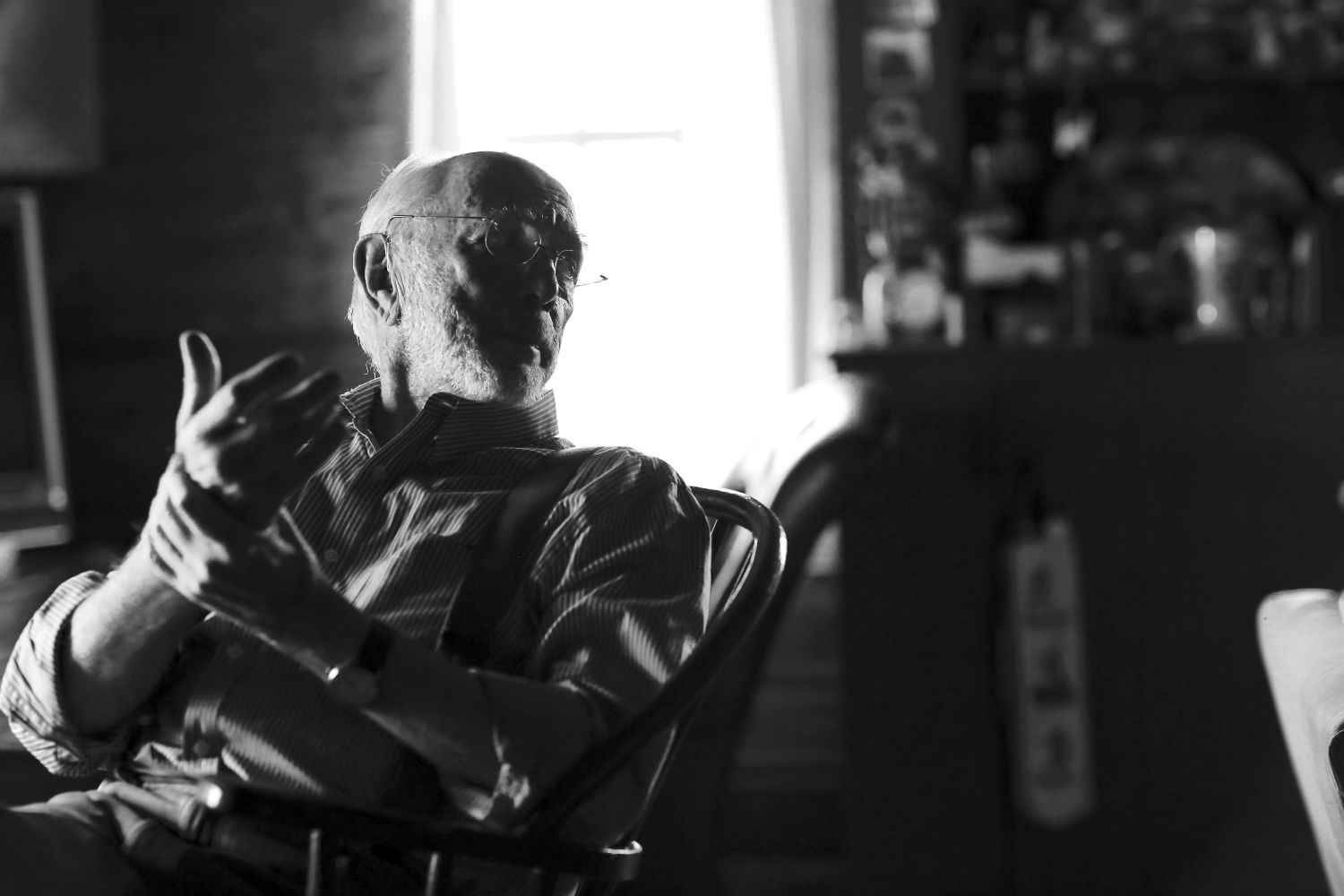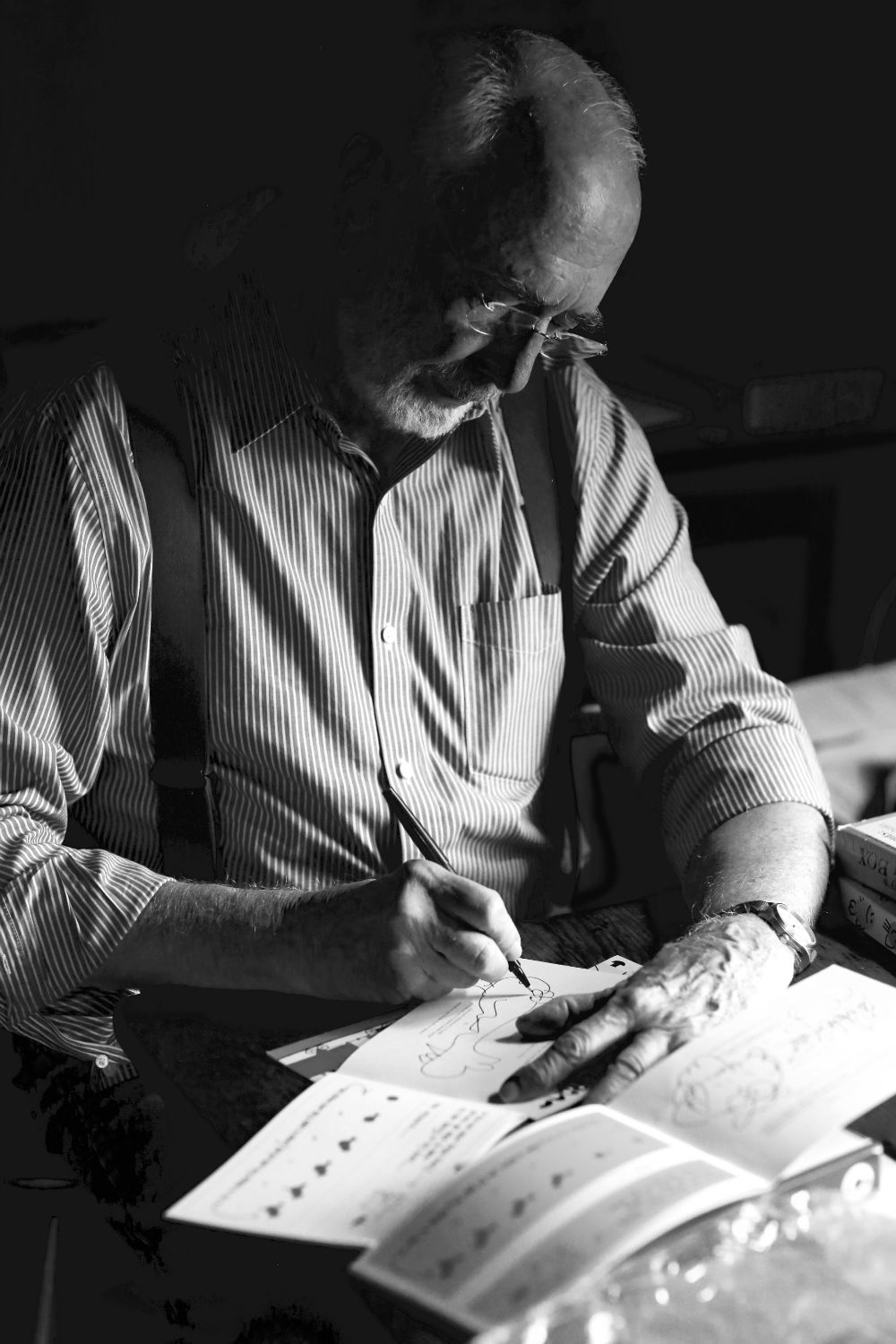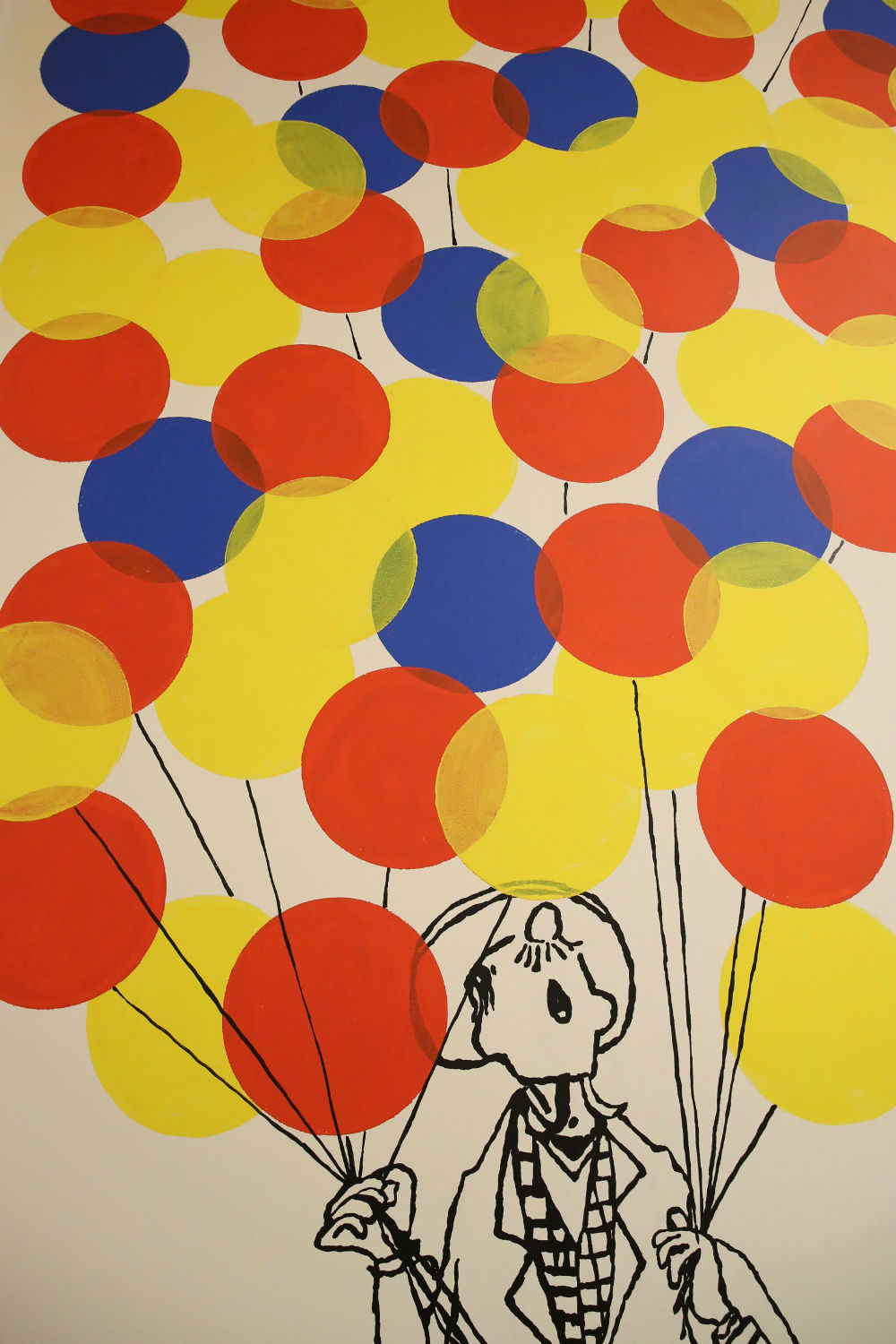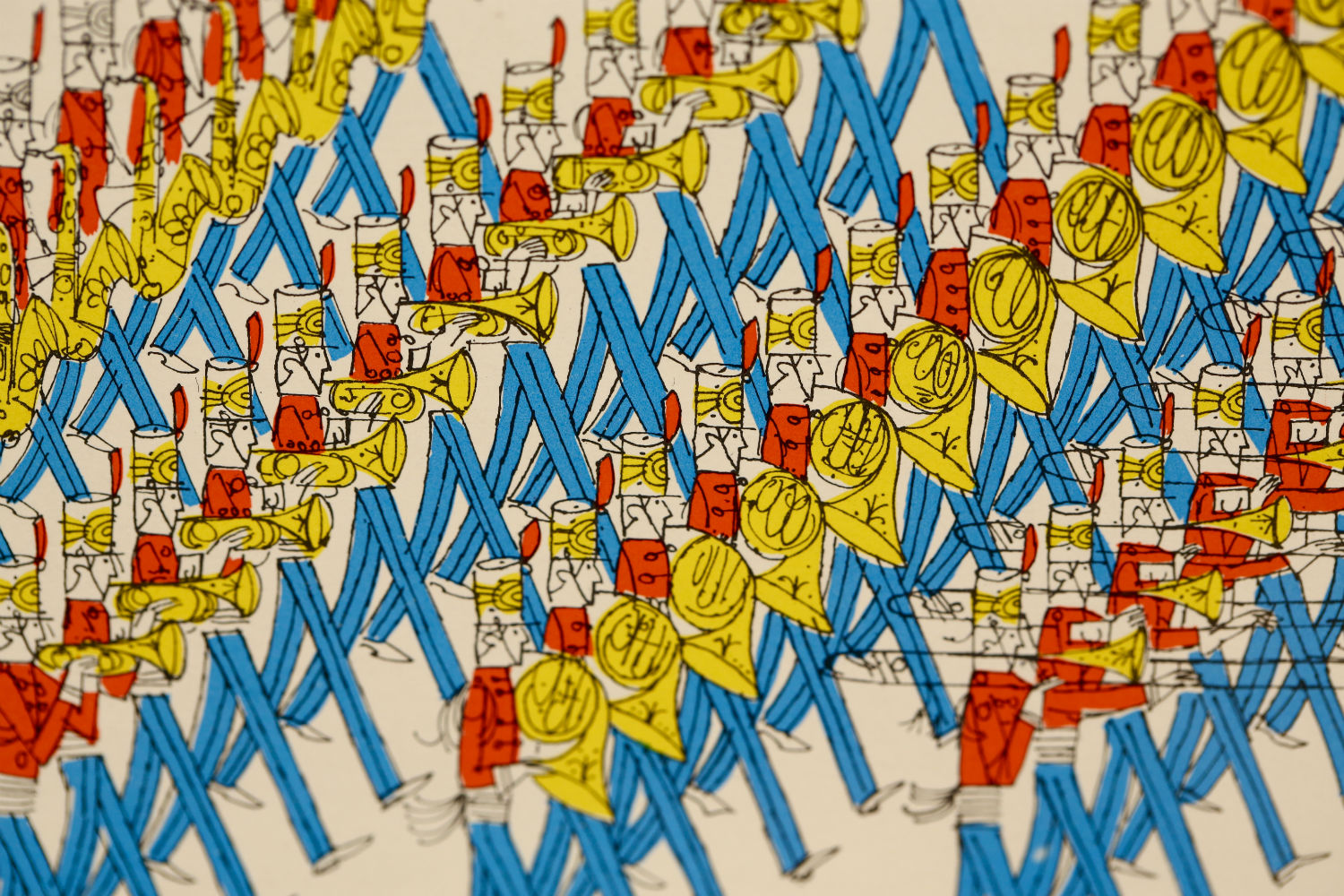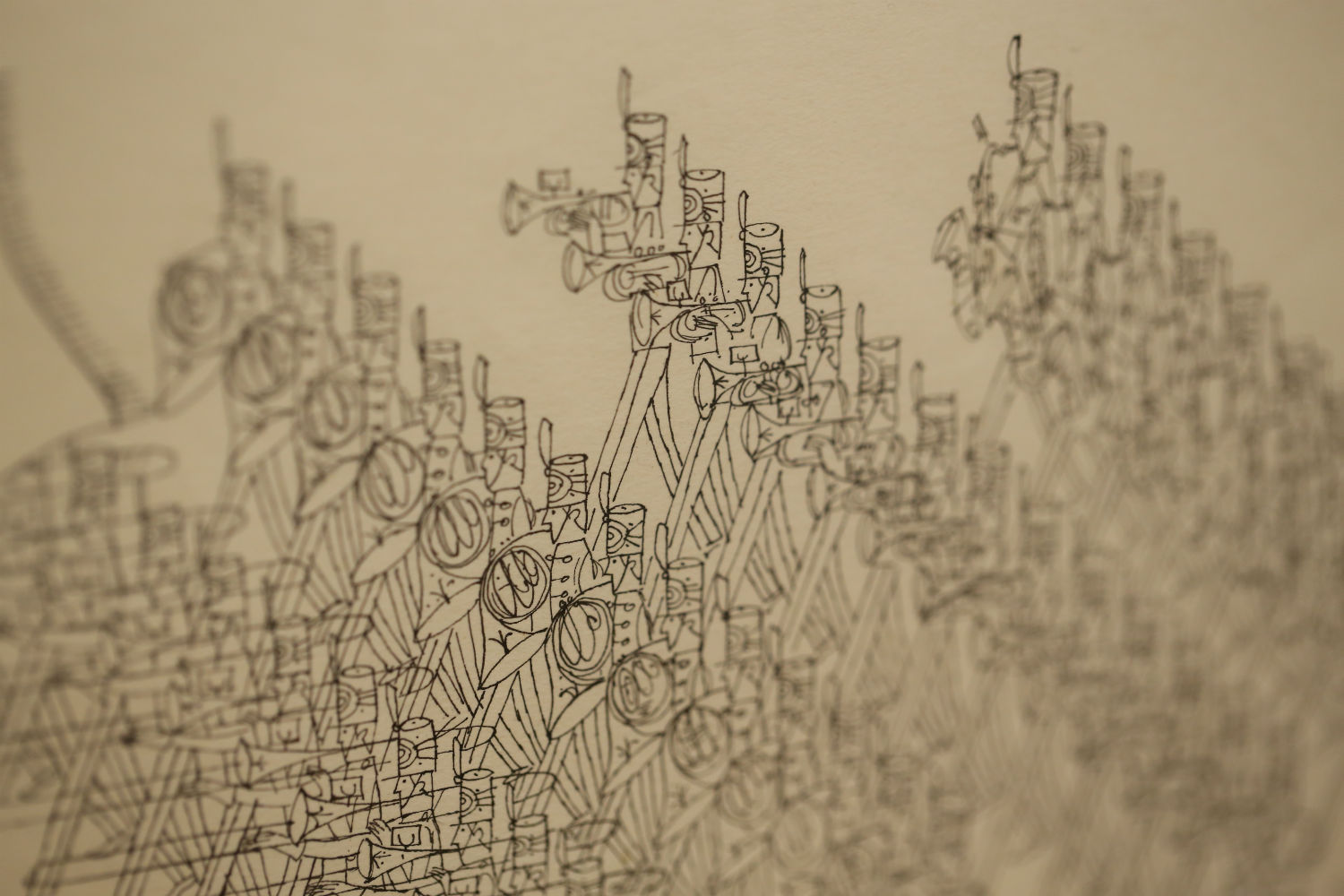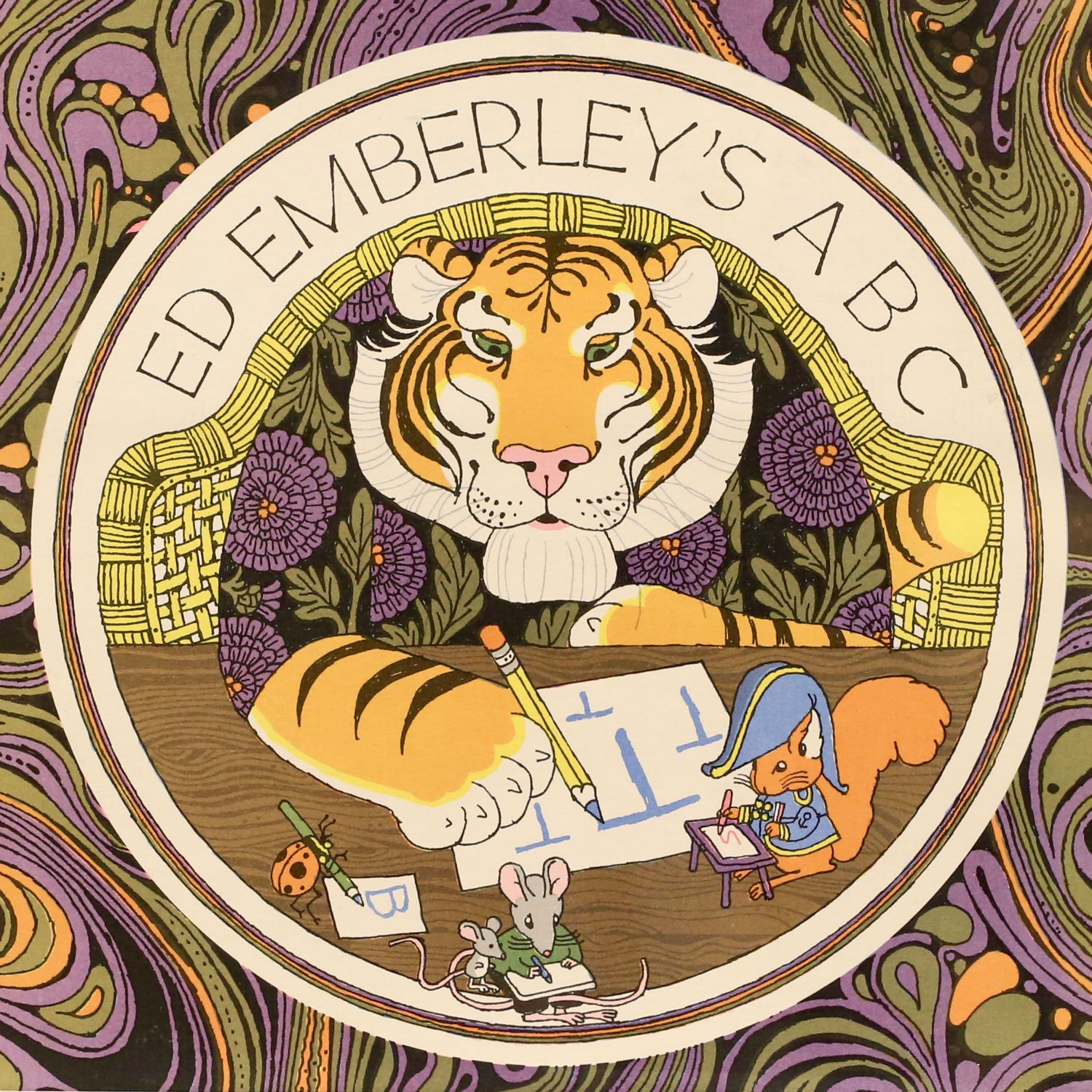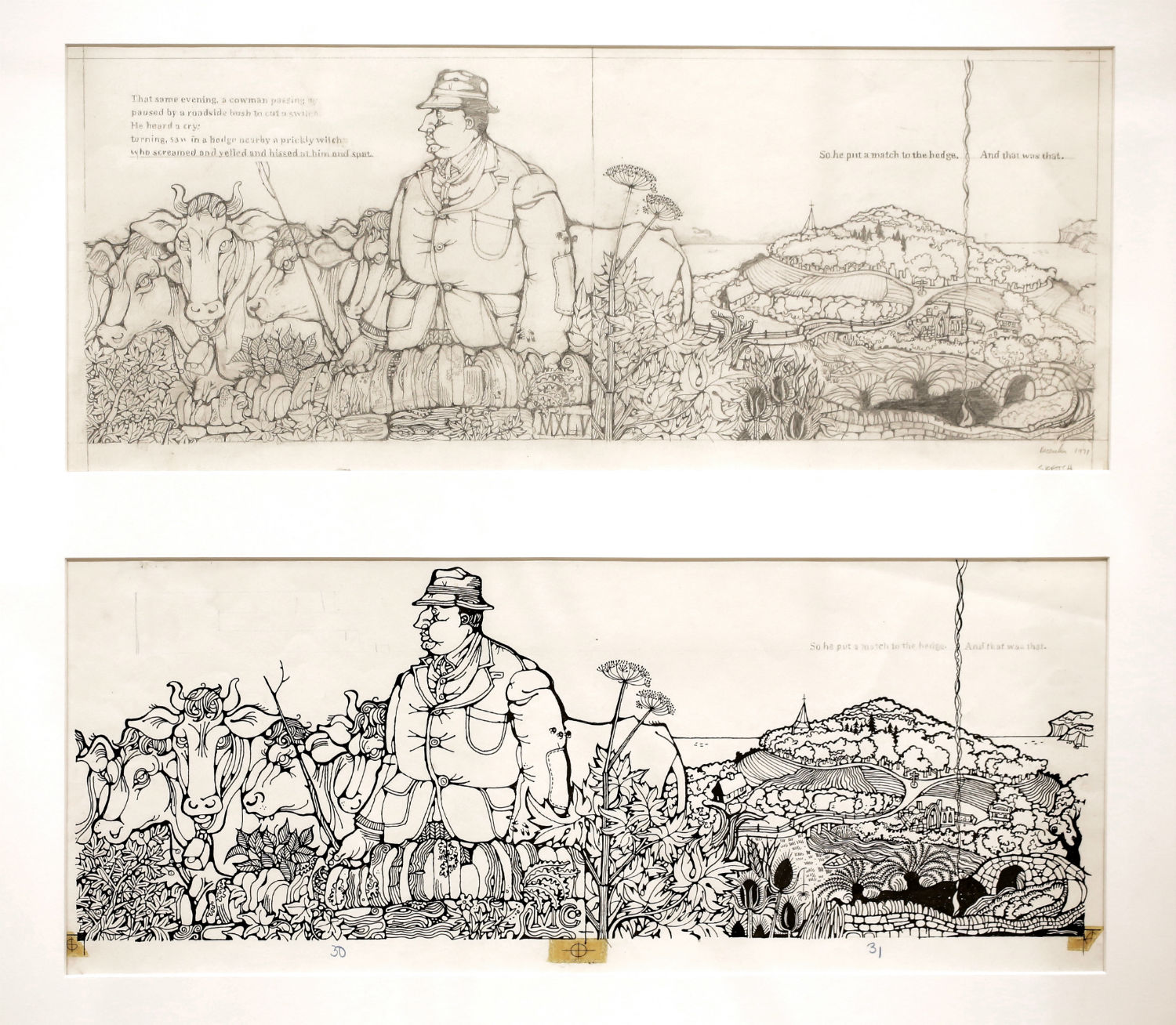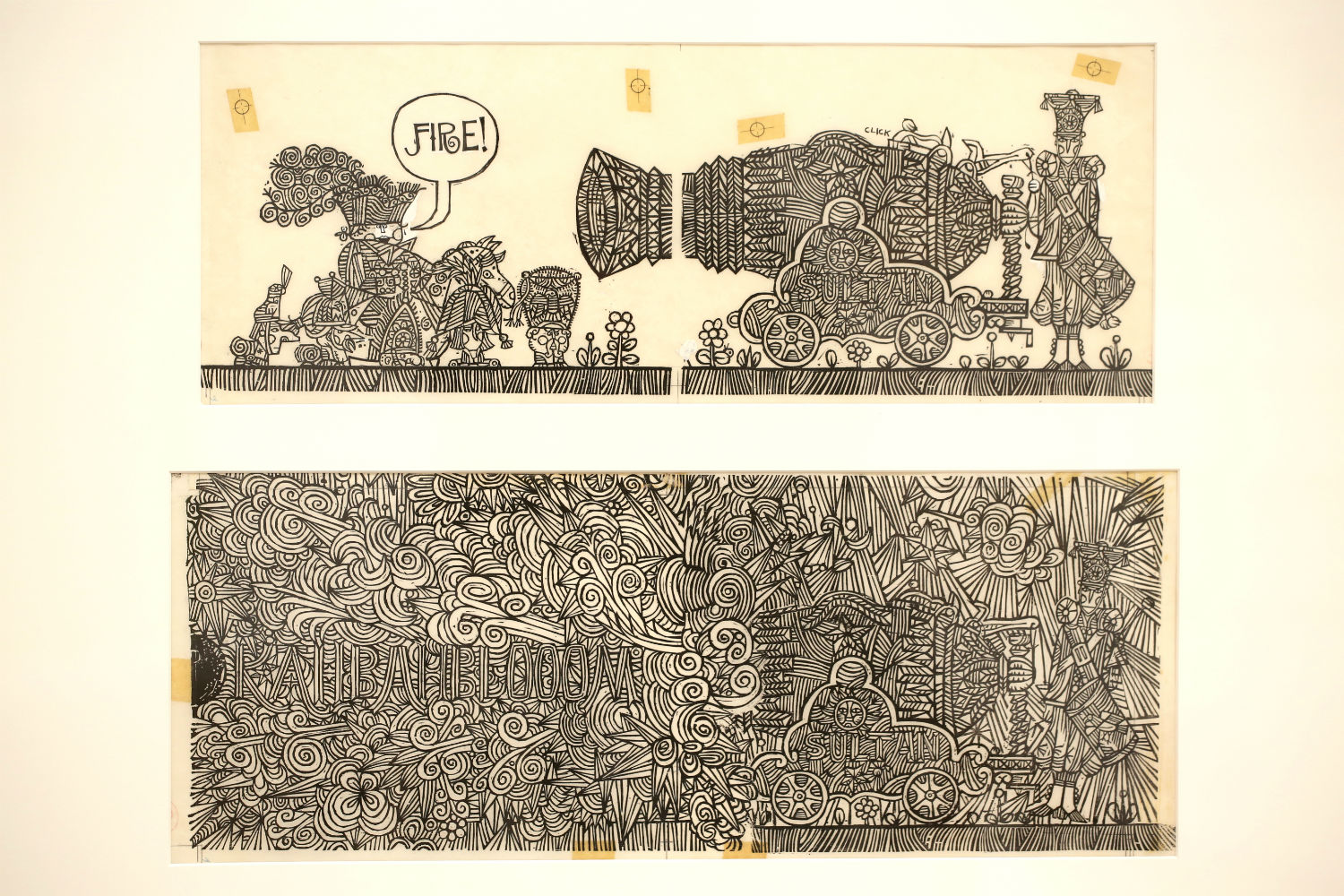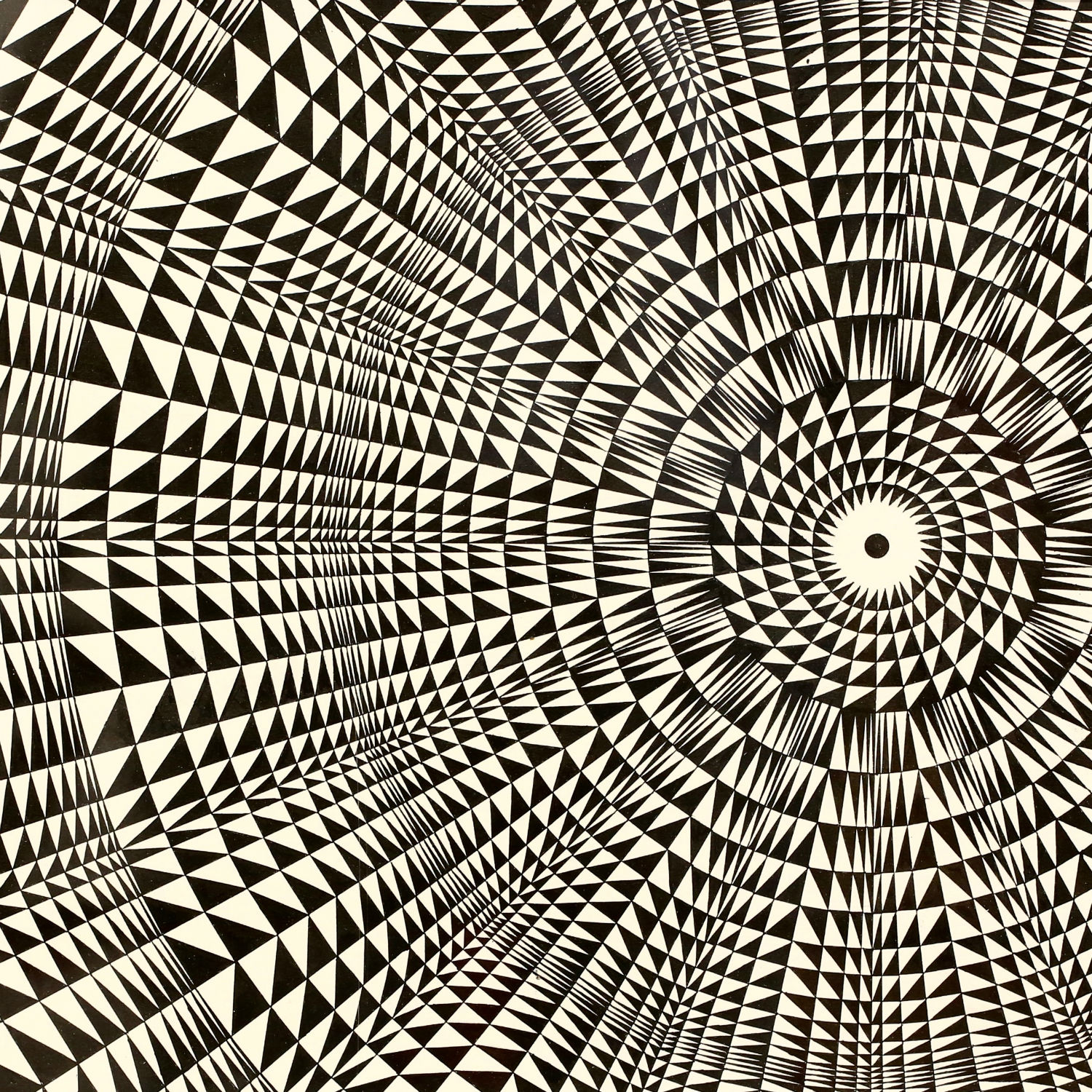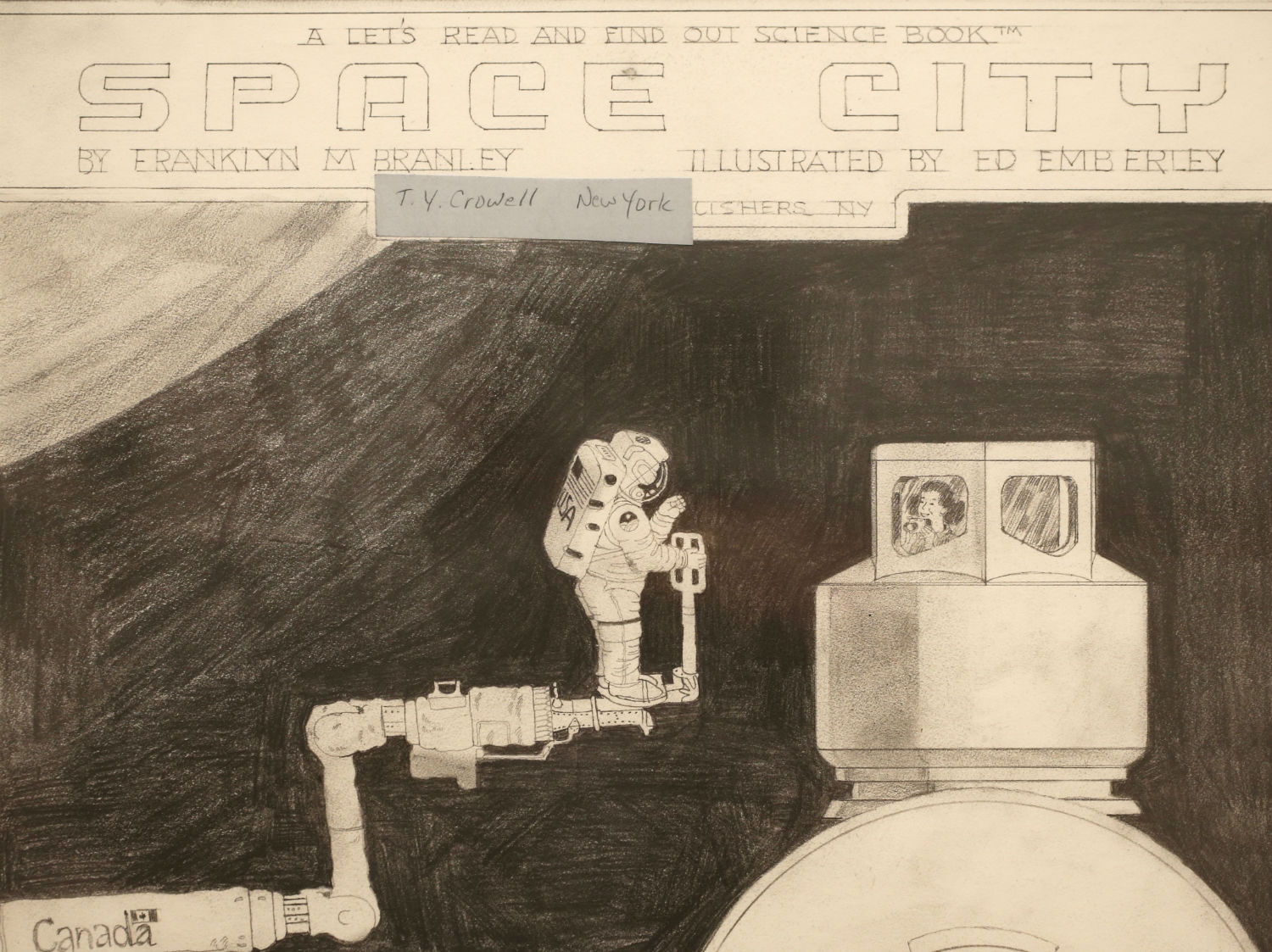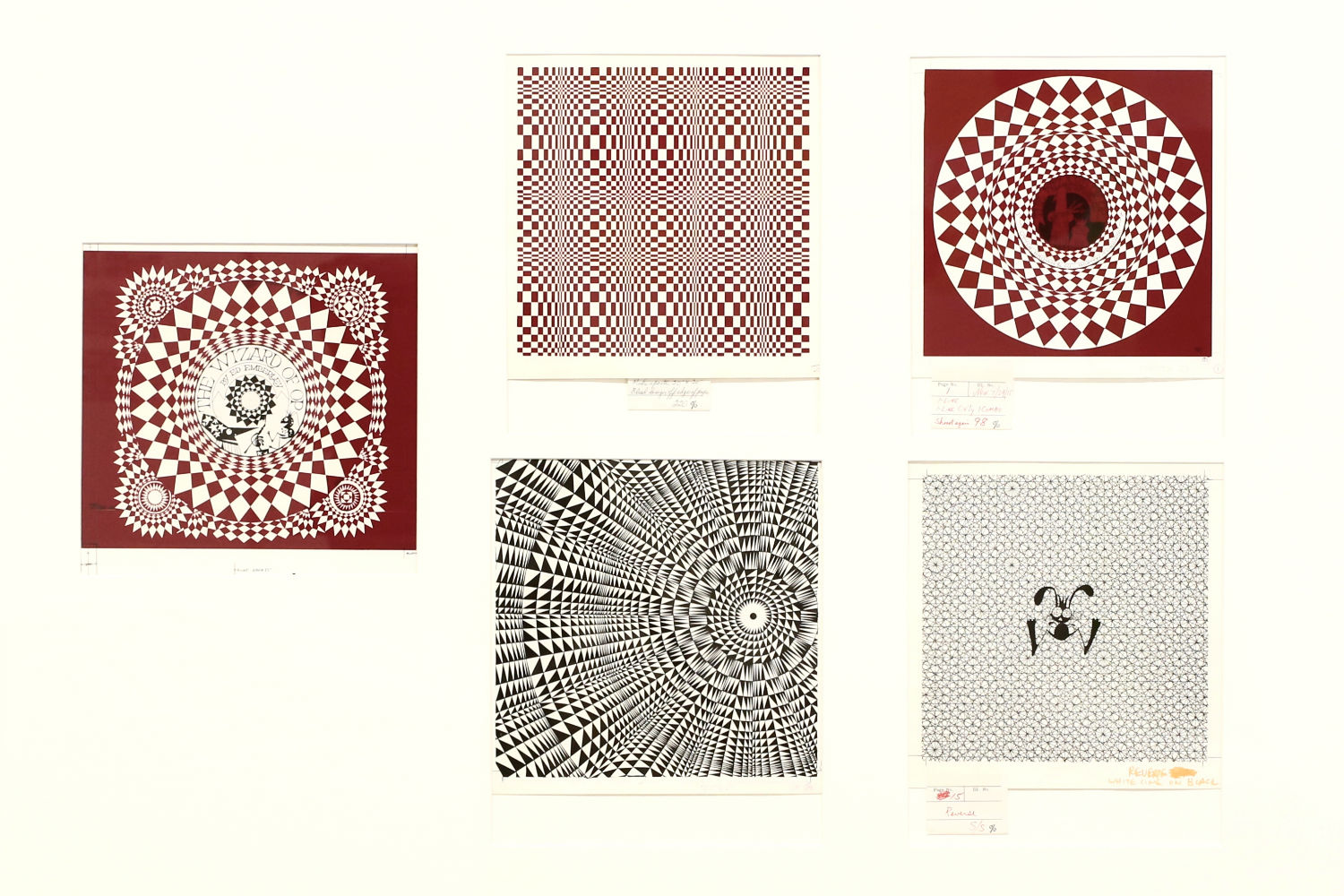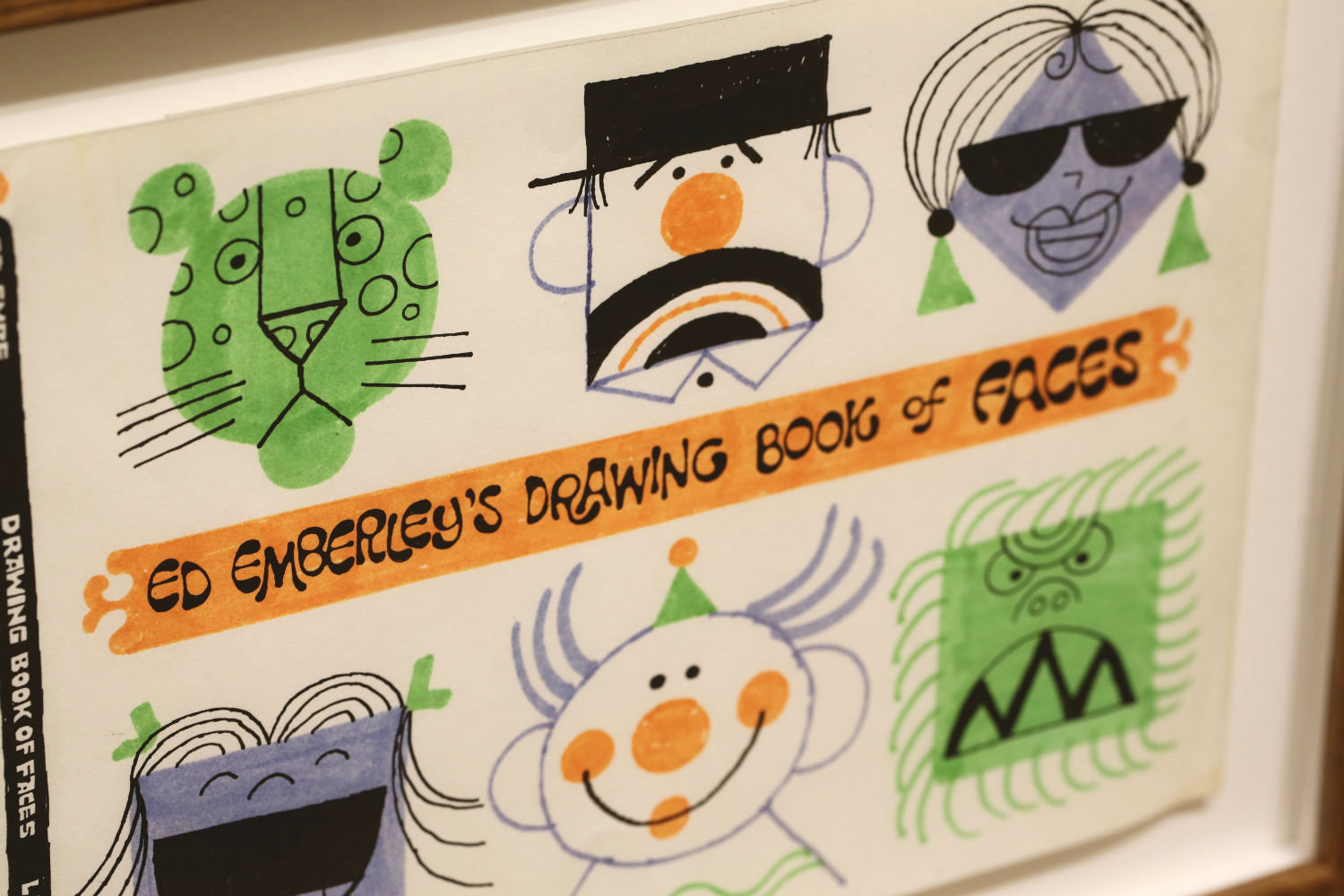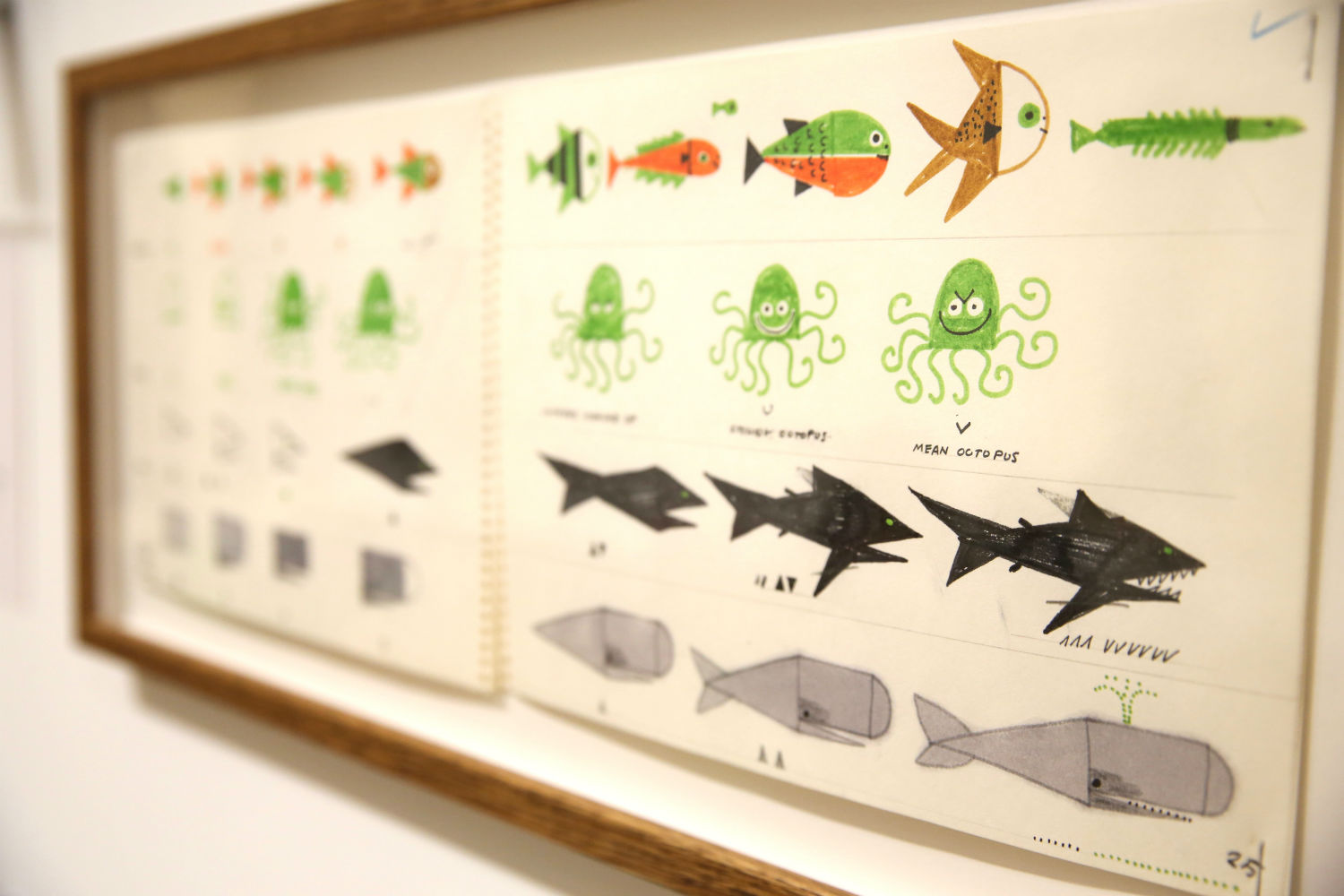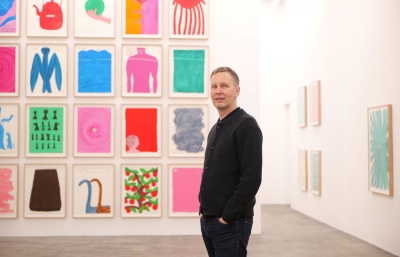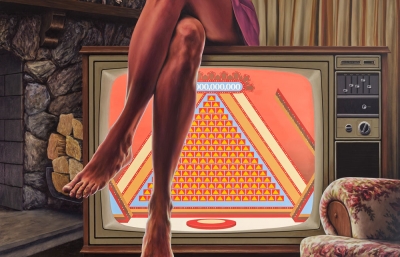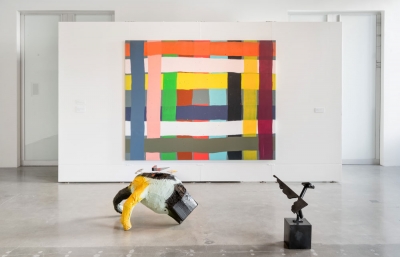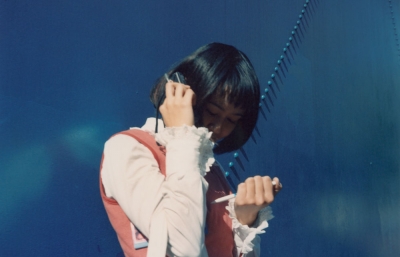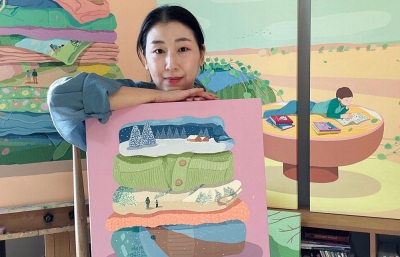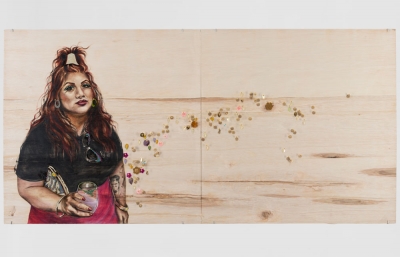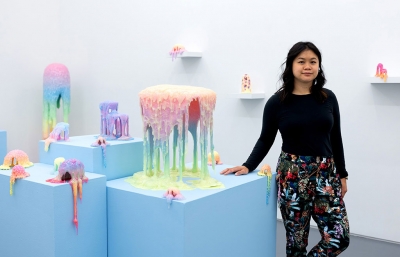From his home in Ipswich, Massachusetts and for nearly sixty years, Ed Emberley has been turning out books for children. At age 85, he is still restlessly creative, continuing to work in many styles that make him one of the most compelling and diversified living American illustrators. Whether masterful line drawings, woodcuts, print-based work, or digital illustration, Emberley has kept moving, too curious to settle into the comfort of one technique or style. His 1970 Ed Emberley’s Drawing Book of Animals and the series that followed would influence generations of young artists—and, most importantly, instill a confidence and joy that kept them drawing.
One of those artists was Eric White, who, while you’d never guess from his adult work, credits Emberley’s books as steady artistic guides through a turbulent part of childhood. White made the trip to Ipswich to meet Emberley on the eve of the first-ever career retrospective of the artist’s work, Kahbahblooom: The Art and Storytelling of Ed Emberley, which runs through April 9, 2017 at the Worcester Art Museum in Worcester, Massachusetts. The show features dozens of never-before-exhibited artworks from well-known Emberley books like the Caldecott honored One Wide River To Cross, and Caldecott winner Drummer Hoff, his seminal Drawing Book series, as well as long out-of-print cult classics Suppose You Met a Witch, Wizard of Op, Cock-a-Doodle-Doo and many others. White interviewed Ed Emberley in the company of his wife Barbara Emberley, their daughter Rebecca Emberley and myself, the lucky curator of Kahbahblooom. —Caleb Neelon
Read this feature and more in the February 2017 issue of Juxtapoz Magazine.
Eric White: I’m an obsessive person, and when I find an author or director or a band that I like, I try to go out and get everything. I did that when I found your Drawing Books as a little kid. As I wrote in my essay for Caleb Neelon and Todd Oldham’s book on your work, you are involved in one of my most distinct memories from childhood. My parents divorced when I was seven years old, and I have this very distinct memory of hearing muffled arguing upstairs while I was downstairs, which was completely dark except for one small light. I had your Drawing Book of Faces, and I obsessively drew the faces in it while listening to the Beatles’ White Album. I was surrounded by chaos but able to control this one little aspect of what was going on.
Ed Emberley: Well, when you draw, you go away. You go to another place. It’s a safe place. And it’s a real place.
You’re in control, or have the illusion of control.
EE: And that’s good enough. It’s all illusion, right? You were listening to an argument that you didn’t want to have to be listening to. When I was in my seventies, I remember being at a party, and two people started to get into a big argument. I’m not an obsessive sketcher, but I had a pad in my lap and started to draw. In about five minutes, I realized that I had been “not there,” that while I was drawing, I had gone away.

Photo by Todd Mazer
Have you been drawing since you were a little kid?
EE: Well, you have to remember how old I am. This was back before World War II. I grew up in Central Square in Cambridge, where my father was a painter and carpenter, and my mother worked in a dress shop. People had expensive toys around us, but I never felt jealous or like I should have them. We had pencils and paper, and that was constant. We didn’t have much money, but we had a little cabin in the woods where we went in the summertime. No electricity, no running water. My grandfather was a carpenter, too, and my grandmother would give us the box of odd triangle cutoff scrap pieces. I had a hell of a time, could play with that for hours, lining them up, making shapes out of them.
And there’s your Drawing Books right there!
EE: All kids are like that. But I had pencils and paper, and I, at some point, decided to try and make a living at it. I had no training in anything else. I washed dishes at Harvard as a teenager.
Were your parents supportive of your art?
EE: Yeah, they were. My father was like most fathers of his generation. He got up and went to work and came home from work, and got up and went to work and came home from work. My mother worked too but also nosed around and figured out how to send me to art classes here and there and so on. They gave me space in the house. When I went to Mass Art, they found the fifty dollars a semester that it cost, or helped me with it. My brother, two years younger than me, he got a camera and taught himself and became a successful fashion photographer. My other brother became a machinist and worked on submarines.
So, why are you an artist? Is it something that came to you? Or a person-to-person interaction?
EE: I complained once to my mother about being bored. She took a walnut, melted wax from a candle into the shell, put a match and a paper sail in it, and made a boat. Now, why do I still remember this? Think of all the hours we live and what we remember from them.

Things like that are huge. You saw the world in a new way the moment she handed that nut sailboat to you.
EE: And I had fun drawing pictures. I liked following step-by-step instructions when I could do them. I didn’t like, and I still don’t like, the so-called drawing books that guarantee a kid to fail. If you present something that is supposed to be the answer, and it’s not the answer, you’ve done damage. And that’s my credo. You’re supposed to do the best you can for kids. You’re not supposed to cheat them. Do no damage.
And so many drawing books just show you how well the guy who did them can draw. What was so great about your books, as well as Betty Edwards’ Drawing on the Right Side of the Brain, was the idea of breaking things down into form.
EE: I wanted the Drawing Books to be a springboard, not a cage.
What was the decision to go to art school like for you?
EE: I don’t know how I made decisions. Even now. To what end did I go to art school? Life came to me. I wasn’t concerned with the fine art world. I didn’t know much about illustration and that world—I had only seen funny books, the illustrated Wizard of Oz, Rockwell. I first went into direct mail advertising doing paste-ups, making fifty dollars a week, and they eventually had me draw cartoony characters. I didn’t really have any goals. Eventually I did some side freelance illustration work that got me a check for a thousand dollars, so I went freelance and I decided I would do everything that anyone asked me to do for one year. At the end of the year, I’d look at what people asked me to do, and how much it paid, and whether I liked doing it. In that year, during downtime, I decided to do a children’s book, which was The Wing on a Flea, my first one. It got a New York Times “ten best illustrated of the year.” You couldn’t really make a living doing children’s books, though, because you could only do one a year with a certain publisher, and advances were in the hundreds of dollars, not enough to live on. But I liked doing them. What I could do, in addition, were things like non-fiction books, textbooks, and I could mix things up and work in different techniques. And I could work with Barbara on—in addition to the pen and ink books I was doing—a series of woodcut books, and sell those to a different publisher. And Barbara worked on preparing a lot of the color separations.
And this was done by cutting Rubylith?
Barbara Emberley: Ed did most of the Rubylith (colored masking film), but I did a lot of the layered separations in black.
This is so interesting to me because younger artists today don’t have any experience with this at all. You’re doing all of these color separations in black—not seeing any of the color until the book comes out.
BE: Yes, it’s really magical. And for some of our books, we had to assign percentages—20% of a certain color or 38% of a certain color. But we always did our own separations. And Ed always did his own design of his books as well. It made a better book.
EE: It was a puzzle. It was a problem to solve. And I always liked the problem solving. When we would go sailing, I never liked day sailing, just to go out and come back. I wanted to go to Nantucket, to Bar Harbor, to deal with buoys and channels and no electronic equipment or beacons.
And the books wouldn’t have been the way they were without you being like that. So how did the Drawing Books come about?
EE: I was forced to. By money. I had won the Caldecott Medal and the publisher was waiting for the next book. They felt the medal was an indication that they appreciated my work and wanted me to do more, as much as it was for the book. But I was working on Suppose You Met a Witch, and that took six months of creating seven or eight overlays, with color over black, two trips to England where the story took place to get the plants and flowers right, and it would take another year. And I told the publisher that I had a little drawing book idea, some things I had played with as a kid. I thought it was a quick novelty greeting-card kind of thing that would come and go. I thought teachers and libraries wouldn’t like it because it was a copying book, that it was the destruction of creativity. But I published it, and it was my Drawing Book of Animals. Like every book I’ve published, it turned out to be a huge seller, and the day it was published, the reviews were huge. Bam! Terrific reviews from the New York Times, fathers saying they took the book home and drew with their kids for the first time; their kids thought they were a genius. It took off from there and sold probably over two million. Many of the other books I did would sell maybe five thousand, ten thousand.
And you never taught in a classroom setting, right?
EE: Right, I never did.
So what was it like then, being a teacher to so many young artists? You must have been getting letters and hearing from them?
EE: Nope. Silence. All we got were sales figures. Sometimes the publishers didn’t even send you the reviews.
I always wondered why I never wrote you a letter.
BE: It took until the next generation to hear back—people like you who are old enough now to get in touch.
But didn’t you ever wonder? You’re doing something that is sort of one-sided. You’re having a tremendous impact on young people, but the feedback is limited to reviews and money. Did you ever think about the impact you were having?
EE: No, I really didn’t. The book was done and I was on to the next one. I’m happy I did that. When the book was done, we piled the artwork up into a box in the studio, and it stayed that way until Caleb came along. We were on to doing the next book.

Photo by Todd Mazer
But you never wondered about the feedback or wanted it?
BE: How could we get it? All we would get is the number of books sold.
It’s so interesting to think of you having this one-way influence on such a massive scale.
Rebecca Emberley: And the children’s book rock star thing didn’t exist then. The whole trend of publishing based on a person’s following online is ridiculous. I’m sure it’s that way in art, as well. And just because you’re good at social media doesn’t mean anything.
It doesn’t. It’s an incredibly narcissistic society.
Caleb Neelon: When putting together this show, one of the questions asked by the museum was to identify the fine artists were who were influenced by Emberley. They were wondering about who was influenced at the time the books came out—but it was the wrong question, in a way. The people who were influenced by Ed Emberley, who were fine artists—well, they are sitting here at this table, people like Eric and me. You had to check back twenty years later on the young people who loved the books as kids to find out if the influence was there.
EE: It’s only the odd times when I go to a restaurant or store and pay with my credit card. “Are you that Ed Emberley?” Then I get a long story from a waitress or someone. Sometimes it takes a second or third or fourth generation for the influence to come back.
RE: And while this is a great achievement to sell so many and for so long, the scale is still small. It’s nothing close to the scale of something like Eric Carle’s The Very Hungry Caterpillar, which sells every minute.
EE: We hear people tell us that they got our books from the library all the time when they were kids. Kids of course can’t really buy the books on their own. They might influence an adult to buy one, but libraries and teachers were the most influential.
CN: Even as kids, Eric and myself were both deeply influenced by the Drawing Books, though neither of us knew about any of the other Emberley books in the many different styles and aesthetics. Even something like Drummer Hoff, which won the Caldecott, I never saw it.

Photo by Todd Mazer
Neither did I. I would have loved them, but all I saw were the drawing books.
EE: And that was a problem I created. If you liked the drawing books and saw a very different book of mine, say a woodcut book like Paul Bunyan, you may have gotten to love one technique, or been disappointed if it was different. I realize that, but I get bored very easily. It would have been hell for me to be Charles Schulz and drawn the same thing always.
But did you like the work of contemporaries like Dr. Seuss and Richard Scarry?
EE: Oh absolutely. Richard Scarry was a genius. And Peter Spier was wonderful. I like a lot of people. And Picasso is my favorite artist.
So, are you excited about Kahbahblooom, your retrospective at the Worcester Art Museum? Does it feel like a milestone?
EE: I feel wary! Who am I? Suppose your good mother got you a surprise present which was to sing at the Met at the opening of a big opera and they shoved you out with your costume on. And everyone is looking at you. That’s the way I feel. I do the work for myself and I’m not overwhelmed with my own wonderfulness. I think it’s fun and I like doing it, I like to please people and I realize that I won’t please everybody. So I’m a little wary. But seeing all the things that Caleb has found in the piles, a hundred books with 32 pages, it goes on. It’s like going through your old clothes. Maybe there is still some life in those old socks!
Caleb Neelon is also co-author with Todd Oldham of the 2014 AMMO Books retrospective, Ed Emberley. Kahbahblooom: The Art and Storytelling of Ed Emberley, is on view through April 9, 2017 at the Worcester Art Museum in Worcester, Massachusetts.
---
Originally published in the February 2017 issue of Juxtapoz Magazine, on newsstands worldwide and in our web store.

